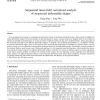877 search results - page 78 / 176 » Complex networks and human language |
100
click to vote
TNN
1998
14 years 11 months ago
1998
—Recurrent neural networks processing symbolic strings can be regarded as adaptive neural parsers. Given a set of positive and negative examples, picked up from a given language,...
SSS
2010
Springer
14 years 10 months ago
2010
Springer
In this paper we present new distributed protocols to color even rings and general bipartite graphs. Our motivation is to provide algorithmic explanation for human subject experime...
103
click to vote
CVIU
2006
14 years 12 months ago
2006
A novel approach is proposed to analyzing and tracking the motion of structured deformable shapes, which consist of multiple correlated deformable subparts. Since this problem is ...
105
click to vote
HCI
2009
14 years 9 months ago
2009
We have explored using neurophysiologic patterns as an approach for developing a deeper understanding of how teams collaborate when solving time-critical, complex real-world proble...
COSIT
2003
Springer
15 years 5 months ago
2003
Springer
Numerous cognitive studies have indicated that the form and complexity of route instructions may be as important to human navigators as the overall length of route. Most automated ...

